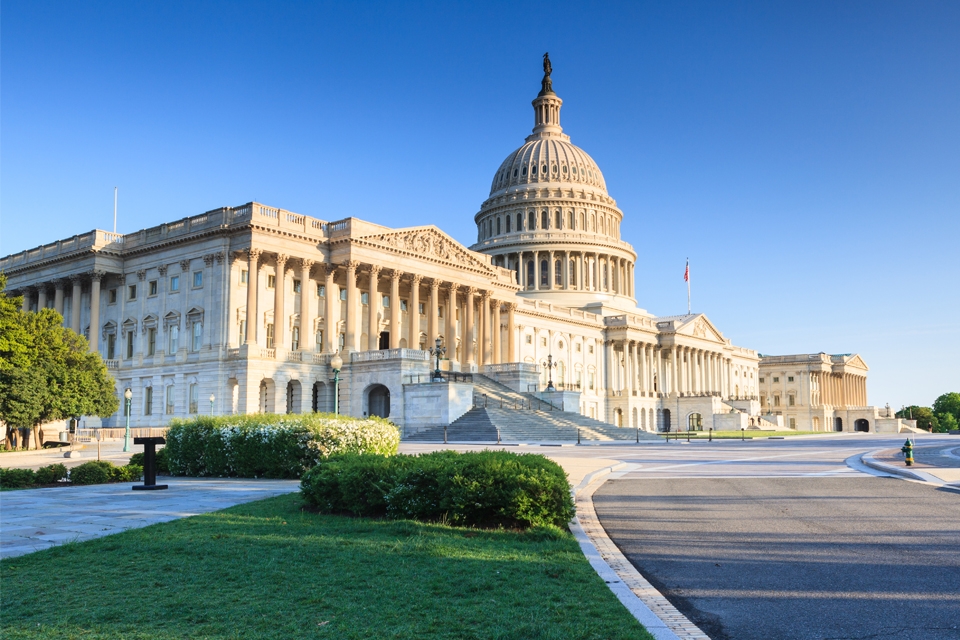Blog Published March 26, 2020 · 10 minute read
Trillions to the Rescue
Ellen Hughes-Cromwick & Zach Moller

Late last night, the Senate passed the so-called “Phase 3” response to the COVID-19 economic crisis facing the country. The House of Representatives is scheduled to pass this vital piece of legislation on Friday. This bill contains many necessary pieces and, like any massive bill, there are some we don’t love or would prefer were different. But fundamentally, as our colleague Jim Kessler put last night, “It’s imperfect. There are aspects we don’t like. PASS IT NOW.”
Why do we need to pass it now? We have a health crisis that is cratering the economy and with it, peoples’ livelihoods. Just last week, over 3 million people filed for unemployment benefits. Even more are out of work because they are part-time, or gig workers and don’t even qualify for unemployment benefits. If we don’t move fast, the rising ranks of unemployed will swell into 10 – 20 million, maybe more. Speedy relief will save lives and livelihoods.
The package’s headline number of $2.2 trillion of assistance really attacks the many dimensions of this crisis that we hope to walk you through. Please note that the dollar amounts are not “budget scoring” in a traditional sense because some of these dollar amounts are for loans that will hopefully paid back and some provisions—appropriations for entitlement programs—would not “score” (i.e., cost zero on paper) under Congressional Budget Office rules.
So, let’s look at a few key pieces of this package, starting with one of the most contentious and heavily debated parts of this bill: the approximately $500 billion in funds for business lending and relief.
Targeted Industry Relief: $500 Billion in Loans and Guarantees (+$33 billion in grants)
To summarize, the rescue package includes the following:
- $25 billion of loans to the commercial passenger airlines ($25 billion in grants to avoid furloughs)
- $4 billion in loans for cargo airlines ($4 billion in grants to avoid furloughs)
- Roughly $4 billion for other airline industry related grants including contractors
- $17 billion in loans for industries required for national security
This aid also is contingent on capping executive compensation at $425,000, preventing stock buybacks and bonuses. The Senate bill also attempts to put in safeguards against abuse by taking nonvoting stock interest in these companies that would be sold off by the US government at a later date. Companies must maintain existing employment as of March 13, 2020 to the extent practicable. Further, the national security borrowers must show that they have incurred losses that affect their ability to undertake business continuity. All loans will be made through the end of this year.
The bill also includes $454 billion for other impacted industries. This will be used under the Federal Reserve Act Section 13(3) lending provisions once approved by the US Treasury Secretary Mnuchin. (See below)
Overall, there will be oversight included these loans with a Special Inspector General of the Treasury with subpoena powers, along with a commission created by Congressional leaders and Federal government officials.
Why is the Federal Reserve a Key Part of this Package?
It’s important to pause for a minute and examine the $454 billion of industry relief. How will those funds be allocated and what industries will benefit from these loans? To start, recall from earlier blogs that the Federal Reserve has set up several programs to provide liquidity to the financial system. For some of these programs, like the Term Asset-Backed Securities Lending Facility (TALF), the US Treasury has provided so-called “credit protection,” a backstop in case some of the loans may or may not be paid back.
In a similar fashion, the relief package includes $454 billion of funding that sits at the US Treasury Department and provides protection against the lack of repayment of other Federal Reserve loans. Further, the Federal Reserve has hinted that they will open a “Main Street Lending Program” soon. This program could offer $4-4.5 trillion in lending with the credit protection backstop of that $454 billion. Think of the $454 billion as a cushion should some companies turn out to not be able to repay their loans from the Fed. This money does not get “spent” unless there are loan losses in the Fed program. Every $1 of credit protection at the US Treasury helps to support $10 of lending at the Fed. This is a vital backstop that could let the Fed, which has been wonderfully responsive to the crisis we are facing, act swifter and stronger to help the economy.
How exposed is the Fed, and thus the American taxpayer, to companies defaulting on their loans? By way of comparison, as of Q4 2019, the default rate of bank business and industrial loans was 1.14%. To be sure, this default rate will increase. However, it still means that most business and industrial loans are “current”, meaning they are making loan repayments. As a result, the cushion that the $454 billion represents means that the Fed can “lever it up” to about $4.5 trillion of lending and still not have to worry too much about using the US Treasury funds.
Unemployment Insurance (UI) Expansion: $260 Billion
The next most debated part of this bill came in the expansion of Unemployment Insurance Benefits. A select few Senate Republicans tried—but were ultimately unsuccessful—to limit this section of bill Wednesday afternoon.
This expansion absolutely essential and, further, is particularly relevant with today’s revisiting 3.3 million initial unemployment insurance claims. The Committee for a Responsible Federal Budget estimates the UI expansions in this bill will cost $260 billion.
Here’s a summary of the changes:
- For the next 4 months, a $600 per-week additional payment will be added to the normal UI benefit. This single provision could do the most good for those being laid off and searching for work. Since the average UI benefit is only $385, this is going to help a lot of people.
- For the first time, benefits are now available for contractors and gig workers.
- Extends UI benefits to last an additional 13 weeks.
One-time payments to individuals and families: An estimated $300 Billion
Finally, the much-discussed checks made the final bill. The legislation provides for one-time checks to go to all eligible Americans which will provide critical support, allowing people to buy groceries, make rent payments, and more.
- Individual checks will be issued in the next few weeks and months for up to $1,200 per person and $2,400 per couple, in addition to $500 per child.
- At upper income levels, the check is phased out by 5% after $75,000 of income ($150,000 if married, and $112,500 if head of household)
- These payments are structured as an advanced tax cut for the 2020 year. If you’ve filed your taxes for 2019 your benefits will be based on your income then, otherwise the IRS will use 2018.
- These payments were greatly improved by Minority Leader Schumer’s negotiations with McConnell and Mnuchin to eliminate the phase in for low-income folks that existed in earlier versions of the bill.
Back to Home Base
To recap, we have traveled far and wide during the last two weeks. This package’s surge of relief and funding is going to go a long way to stemming this economic and health crisis. This bill is not the end of government support! As we speak, many companies’ financial health is deteriorating to “junk” status. These companies, as of today, will not be able to access funds from the Fed – they simply are not credit worthy. Perhaps the Fed will open up lending to below investment grade companies. That could be something we will watch carefully. We are also looking for accountability. Speed of implementation is vital, nay mandatory.
During the Global Financial Crisis, remember how long we waited for the Fed to act, and then for the Congress to pass TARP? All of the stimulus they provided was simply not enough. A dozen or so companies laid off over 700,000 people. Many of those layoffs happened in the banking sector. But it also happened across the country. Many companies, through no fault of their own, were side swiped by the havoc caused by financial market players.
More stimulus and support should be unleashed if this injection falls short of mitigating the economic difficulties confronting workers businesses, and communities.
Appendix: Memo to Our Readers
We will be tracking details and analyzing the impacts of this massive package in coming days. For now, we are attaching as a supplement here the remaining elements of the CARES Act for purposes of giving you a complete picture.
Small Business Relief: $377 Billion
- $350 billion in loans and forgiveness for Small businesses with terms determined by the Small Business Administration. The maximum loan is capped at $10 million.
- These loans are directed to be used to cover payroll costs up to $100,000 per employee for companies with less than 500 employees.
- The maximum loan amount is 2.5 times the average monthly payroll outlays incurred over a one-year period prior to the date of the loan.
- If the business borrower keeps employees on the payroll for 6 months, then these loans could be forgiven and will not require repayment.
- The loans may be used for payroll costs, mortgages and rents, utilities, healthcare costs, and other debt obligations.
- If the small business has already laid off workers, you can rehire these workers and then can take advantage of the provisions in this loan program
- Nonprofits can also apply for these funds.
- $10 billion for emergency grants from SBA for small dollar operating costs (up to $10K)
- $17 billion for 6 months of payments to for existing SBA loans.
Assistance for State and Local Governments: $150 Billion
- Each state receives a minimum of $1.5 billion. $8 billion of these finds will go to Tribes
FEMA
- $45 billion for the FEMA disaster assistance fund
Schools and Colleges
- $31 billion to create an education stabilization fund for states, school districts and colleges.
- Further, there are under $1 billion in appropriations for the Department of Education.
- A new individual tax exclusion for employers paying student loans
Public Transit
- $25 billion in emergency direct assistance to transit agencies to compensate for lost revenue.
Safety Net Funds
- SNAP & Children’s nutrition is appropriated an additional $25 billion to compensate for the expected increase in eligibility. Because this is appropriated entitlement it has no CBO score.
- Additional safety net spending in child and family services and housing are also included for about $17 billion.
Aid to Hospitals and other Health Care Providers: $180 Billion
- $100 billion fund for hospitals and providers hit the hardest.
- Funds for purchases of protective gear, testing supplies and emergency operation centers
- Help for community health centers
- Additional Medicare payments, telehealth and home service funding, and public health agency support such as for the Center for Disease Control and Prevention.
- Additional health spending at the VA and DOD.
Business Tax Cuts
- Expanded tax deductions for interest, rising from 30% to 50%
- Expanded ability to deduct losses from taxable income.
- Delays in payroll taxes paid by employers on the wages of their employees. The 6.2% payroll tax on wages that businesses usually pay would be delayed and extended over the next two years with 50% due at the end of 2021 and any remaining taxes due by the end of 2022. While most or all of these taxes will eventually be paid it will provide roughly of $300 billion in short-term liquidity.
- An employee retention credit for employers who were forced to close or take major losses as a result of COVID-19.


